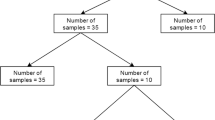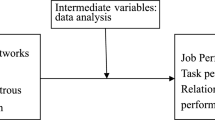Abstract
With the advent of the big data era, some new quantitative tools for enterprise radical innovation research have also emerged. The use of algorithms in machine learning can improve the deficiencies of the current methods of evaluating the technological innovation capability of enterprises. Based on the characteristics of radical innovation and the evaluation mode of traditional innovation performance, an evaluation index system of enterprise radical innovation performance is constituted by six dimensions of resources, technology, product, management, commercial value and social value, and a performance evaluation model of enterprise radical innovation is established by applying the BP neural network. Through model training and simulation verification on radical innovation performance evaluation of the sample enterprises, the results show that the method has high reliability and the model has good generalization ability.




Similar content being viewed by others
References
Li H, Xiong X (2010) Research on the impact of complementary assets on radical innovation performance—a theoretical model. Sci Technol Manag 7:64–71
Chen J, Dai L, Li L (2002) Radical innovation and identification. Sci Technol Manag Res 5:22–28
Li S (2009) Grey fuzzy comprehensive evaluation model for radical technical innovation identification. Technol Prog Countermeas 4:127–129
Zeng P (2011) Research on the relationship between enterprise innovation network characteristics and radical technological innovation performance. Central South University, Changsha
Ma B, Daming, Hu X (2013) Research on enterprise radical innovation identification model based on support vector machine. Soft Sci 1:109–111
Qin J (2012) High performance work practice system, knowledge diffusion and radical innovation. Sci Res Manag 1:71–78
Yin H (2012) Research on the impact of team knowledge conflict on enterprise radical innovation performance. Sci Technol Prog Countermeas 16:120–125
Yang X, Zhang K (2010) Obstacles and countermeasures for enterprises to use radical technological innovation. Econ Manag 6:85–88
Zheng Q, Luo J (2016) Evaluation of technological innovation efficiency of pharmaceutical enterprises. Stat Decis Mak 2016(14):12–42
Wang L, Liu K, Song L (2004) Based on technical discontinuous irreversible product substitution trap research. China Ind Econ 7:105–110
Wu W, Liu J, Zhang A, Li N, Wang J (2016) Empirical analysis of technological innovation efficiency of energy industry based on DEA—Malmquist index. Ecol Econ 6:15–18
Leifer R, McDermott C, O’Connor G et al (1983) Radical innovation: how mature. Eng Manag 30(1):2–11
Cooper R (1983) A process model for industrial new product development. IEEE Trans Eng Manag 30(1):2–11
Cai Q, Si C, Zhao M, Ma L (2005) Based on radical technological innovation, enterprise technology leap opportunity window research. Sci Manag Res 2:15–20
Lu J, Han G (2002) Enterprise technical innovation ability evaluation of the close value method model. Sci Res Manag 1:54–57
Han L (2002) People. Engineering and neural network theory design and application. Chemical Industry Press, Beijing
Xia W, Lv X (2005) Evaluation and application of enterprise technological innovation capability based on BP neural network. Res Dev Manag 1:50–54
Xu D, Wu Z (2002) Based on MATLAB based system analysis and design—neural network. Xi’an Electronic and Science University Press, Xi’an
Author information
Authors and Affiliations
Corresponding author
Rights and permissions
About this article
Cite this article
Li, H., Zhang, Q. & Zheng, Z. Research on enterprise radical innovation based on machine learning in big data background. J Supercomput 76, 3283–3297 (2020). https://doi.org/10.1007/s11227-018-2542-z
Published:
Issue Date:
DOI: https://doi.org/10.1007/s11227-018-2542-z




